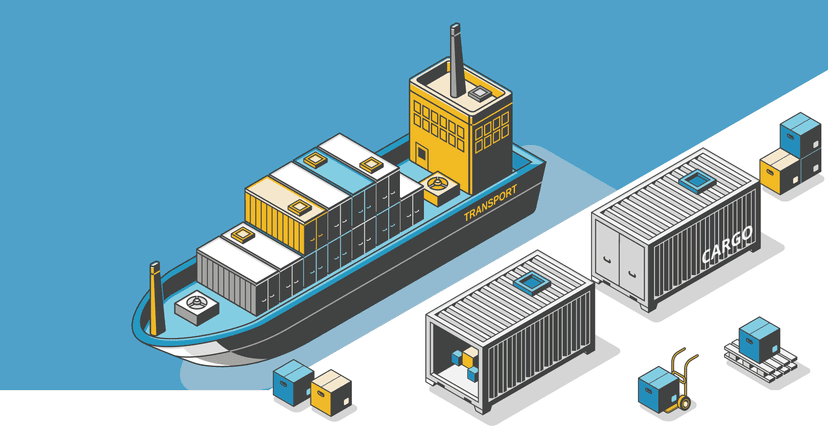
The Ultimate FCL Shipping Handbook: Costs, Benefits, and Best Practices for 2025
FCL shipping (Full Container Load) involves hiring an entire shipping container exclusively for your cargo, offering faster transit times an...
In terms of cost, time, and dependability, multimodal transportation gives supply chains the flexibility to select and create the ideal modal mix.

Logistics expenses might be decreased if freight could be transferred seamlessly between road transport and other modes of freight transit. The government's initiative to create Multi-Modal Logistics Parks (MMLPs) promises to reduce logistics costs and cut down on transportation delays.
The Indian government has undertaken several measures over the years to improve the nation's logistics system and promote efficient freight movement. According to estimates, India spends close to twice as much on supply chains and logistics as industrialised nations like the US, Japan, South Korea, and Singapore, or around 14% of its GDP.
Multi-Modal Logistics Parks (MMLPs) are to be developed as part of the National Logistics Policy 2022 for increased efficiency and connectivity. To do this, however, several obstacles must be overcome, including securing a sizeable amount of funding, adjacent land for building, and enticing policies to encourage developers. Therefore, a multifaceted strategy would be necessary to provide an enabling environment and lay a solid foundation for MMLPs.

A stable policy environment, clear governance structures, and a secure investment and financing framework are some of the essential elements needed to lay a strong basis for a logistics network supported by MMLPs. To further guarantee the success of MMLPs, well defined operational models concentrating on interactions among governmental bodies, the private sector, and industries would be required.
MMLPs are logistical facilities created with assistance from state and central government organisations, and active private sector participation. They are planned to have the infrastructure required to accommodate liquid cargo, grain silos, bulk cargo, containerized cargo, bulk cargo, and other logistics modes based on regional economic demands, and to promote efficient logistical operations.
The Ministry of Road Transport and Highways' (MoRTH) Logistics Efficiency Enhancement Programme (LEEP) launched the MMLP in 2017, and it has since grown to be the country's most significant transformational multimodal initiative. As an integrated freight handling facility, MMLPs are made to perform a variety of value-added activities to streamline and improve the efficiency of the entire supply chain. MMLPs would operate according to a hub-and-spoke system, acting as the central warehouse for nearby regions' freight activities.
Incentives for sustainability and scale should be related to MMLPs to draw capital and lower the cost of logistics for the economy. For the industry to lower its cost-to-GDP ratio and introduce speed and cost reductions, the development of warehousing and material handling based on international standards is essential. The future of scalable, contemporary, automated, and effective warehousing in India may be MMLPs, which might improve India's export competitiveness, speed up trade, and decrease regional inequality.

Efforts to decarbonize the logistics industry would lower carbon emissions and assist India in meeting its obligations under the Nationally Determined Contributions (NDCs). The decarbonization of the transportation sector in India has received more attention because it accounts for over 14% of the country's carbon emissions.
The sustained growth of the world economy requires the support of a successful freight transportation system, which is becoming more and more important because of growing global economic integration. Multimodal transportation, which utilises two or more modes of transportation, has the potential to significantly increase transportation efficiency while lowering transportation costs for the entire process integration organisation.
According to data, multimodal transportation can increase transportation efficiency by 30%, decrease cargo damage by 10%, lower transportation costs by 20%, lessen traffic on the roads by more than 50%, and increase energy conservation and emissions reduction by more than one third.
Businesses can improve the sustainability and resilience of their supply chains by implementing the proper multimodal approach. For businesses that rely mostly on trucks, for instance, roadwork and regular traffic congestion might be a challenge for deliveries that must be made on time.
Even for non-bulk freight and shorter distances, switching to rail or inland waterways for some of the distribution demand may prove to be the best option. Combining rail and air freight could be another way to cut expenses while maintaining day-definite service. Another option is to mix air and ocean travel.

a) Reduces time lost at transhipment sites: Multimodal transport, which is planned and coordinated as a single operation, reduces time lost at transhipment points as well as the danger of cargo loss, theft, and damage. At transhipment sites, the multimodal transport operator arranges interchange and onward carriage efficiently while keeping his own communication channels.
b) Offers faster goods transit: Multimodal transport lessens the drawbacks of being far from markets and locking up capital by enabling faster goods transit. Due to the growth of multimodal transportation, the distance between the origin or source of materials and the customer is expanding in this period of globalisation.
c) Reduces paperwork and formality burden: The amount of paperwork and other formalities associated with each link in the transport chain are kept to a minimum.
d) Single window operation: To transport products, the consignor must deal only with the multimodal transport operator. This includes resolving claims for lost, damaged, or late deliveries at their destination.
e) Lowers export costs: The inherent benefits of a multimodal transportation system will contribute to lowering export costs and enhancing their ability to compete on the global market.
To spur infrastructure development, the Indian government plans to finish building 35 Multi-modal Logistics Parks over the coming years.